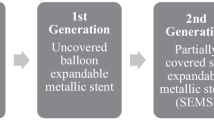Abstract
Interventional pulmonology, otherwise known as “airway stenting,” has developed in the field of pulmonary medicine focused on using advanced bronchoscopic techniques to treat airway disorders. Tracheobronchial disorders can be caused by malignant or benign tumors, extrinsic compression, postintubation tracheal injuries, tracheobronchomalacia, or sequelae after tracheostomy. Tracheobronchial prostheses, known as airway stents, are used to palliate the effects of large airway obstruction. Specially designed stents are being used increasingly, not only in the airways, but also in the biliary tree, esophagus, urinary tract, and vascular system. There are two main types of airway stents currently available; tube stents made of silicone, and expandable metallic stents. Silicone stents are usually placed with the aid of a rigid bronchoscope while the patient is under general anesthesia. Unlike silicone stents, metal stents can be placed with a flexible bronchoscope. We examine the advantages and disadvantages of currently available stents and present our thoughts on the future development of airway stenting.
Similar content being viewed by others
Author information
Authors and Affiliations
Rights and permissions
About this article
Cite this article
Saito, Y., Imamura, H. Airway Stenting. Surg Today 35, 265–270 (2005). https://doi.org/10.1007/s00595-004-2942-y
Received:
Accepted:
Issue Date:
DOI: https://doi.org/10.1007/s00595-004-2942-y




